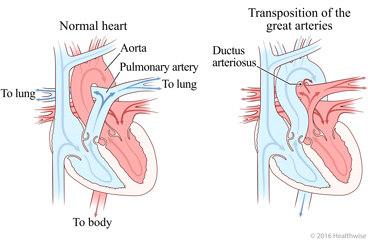
What is transposition of the great arteries?
Transposition of the great arteries is a type of congenital heart disease. Congenital heart disease refers to heart problems a baby is born with. These heart problems are usually diagnosed at or before birth.
The "great arteries" are the two main blood vessels attached to the heart: the aorta and the pulmonary artery.
- The aorta carries oxygen-rich blood (red blood) from the heart to the rest of the body.
- The pulmonary artery carries low-oxygen blood (blue blood) from the heart to the lungs to pick up oxygen.
In transposition of the great arteries, the two blood vessels are reversed (transposed).
- The aorta is sending red blood to the lungs instead of out to the body.
- The pulmonary artery is sending blue blood out to the body instead of to the lungs.
The baby's body is still getting some red blood because of a small blood vessel that connects the left and right sides of the heart. This blood vessel, called the ductus arteriosus, is normal. It is part of the circulation system before birth. Normally it closes shortly after birth. Medicine may be given to keep this blood vessel open so the baby's body gets some blood with oxygen.
There may be other problems in the baby's heart that will also need treatment. For example, there may be a hole in the wall separating the two sides of the heart. When there is a hole, red blood and blue blood get mixed together instead of staying separate.
Your baby will need special care in the neonatal intensive care unit (NICU). This may be scary for you. But the hospital staff understands this. They will explain what happens and will answer your questions.
How is it diagnosed?
Your doctor may hear abnormal heart sounds, such as a heart murmur, when they examine your newborn.
Your doctor will order tests to find the cause of abnormal sounds or of symptoms. The most common test used to identify this problem is called an echocardiogram, or "echo" for short. It uses sound waves to make an image of your baby's heart.
Other tests, such as an EKG (electrocardiogram), chest X-ray, and checking the amount of oxygen in the blood, also help identify the problem.
A fetal ultrasound, which looks at the baby's heart, may find this problem before birth.
What are the symptoms?
Some babies have few symptoms at first. But because the body isn't getting enough oxygen, symptoms may later include fast breathing and a blue tint to the skin, lips, or fingernails.
How is it treated?
Your doctor will help you understand your choices and what to expect from each choice.
Your baby may get medicine to keep the ductus arteriosus open. This helps keep red blood flowing to the body. It is often given through a blood vessel in the belly button.
Your doctor may do a treatment called cardiac catheterization. This procedure creates a hole between the upper chambers of the heart. This hole helps red blood mix with blue blood so the baby's body can get more oxygen. Your baby will be asleep during this procedure. The doctor puts a thin tube into a blood vessel in your baby's groin. This tube is called a catheter. The doctor moves the catheter through the blood vessel to the heart. The doctor moves special tools through the catheter to the heart to create the hole.
Open heart surgery is needed to cut and switch the two arteries. If there are other heart problems, they may be repaired at the same time.
What can you expect?
- You may see tubes and wires attached to your baby. This can be scary to see. But these things help the doctor treat your baby. The tubes supply air, fluid, and medicines to your baby. The wires are attached to machines that help the doctor keep track of your baby's vital signs. These include temperature, blood pressure, breathing rate, and pulse rate.
- The hospital staff will give your baby the nutrition that your baby needs. The doctor may feed your baby through a soft tube that goes through the nose and into the stomach. Or the doctor may use an I.V. that goes through the belly button to do this.
- Your baby may need oxygen. It is given to the baby through a tube in the nose or throat.
- Your baby will be kept comfortable and warm.
- It may seem that your baby is getting lots of tests. All of these tests help your doctor keep track of your baby's condition and give the best treatment possible.
- It's hard to be apart from your baby, especially when you worry about your baby's condition. Know that the hospital staff is well prepared to care for babies with this condition. They will do everything they can to help. If you need it, ask for support from friends and family. You can also ask the hospital staff about counselling and support.
Follow-up care is a key part of your child's treatment and safety. Be sure to make and go to all appointments, and call your doctor or nurse advice line (811 in most provinces and territories) if your child is having problems. It's also a good idea to know your child's test results and keep a list of the medicines your child takes.
Where can you learn more?
Go to https://www.healthwise.net/patientEd
Enter J355 in the search box to learn more about "Learning About Transposition of the Great Arteries in Newborns".
